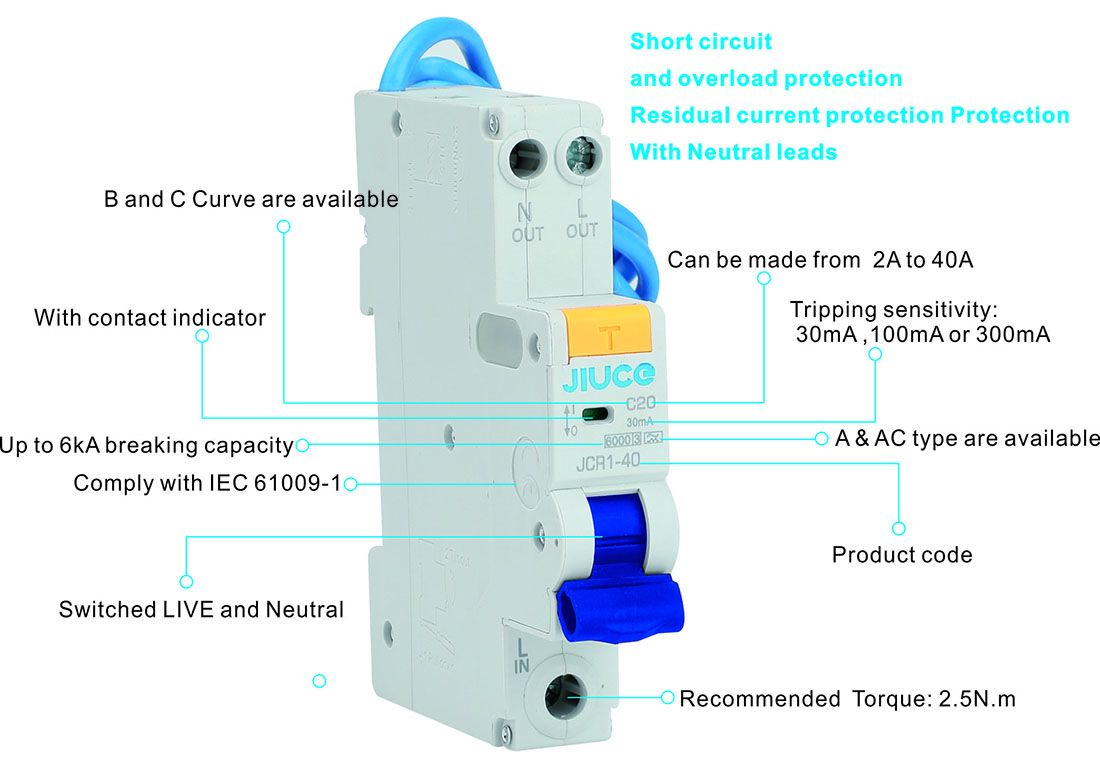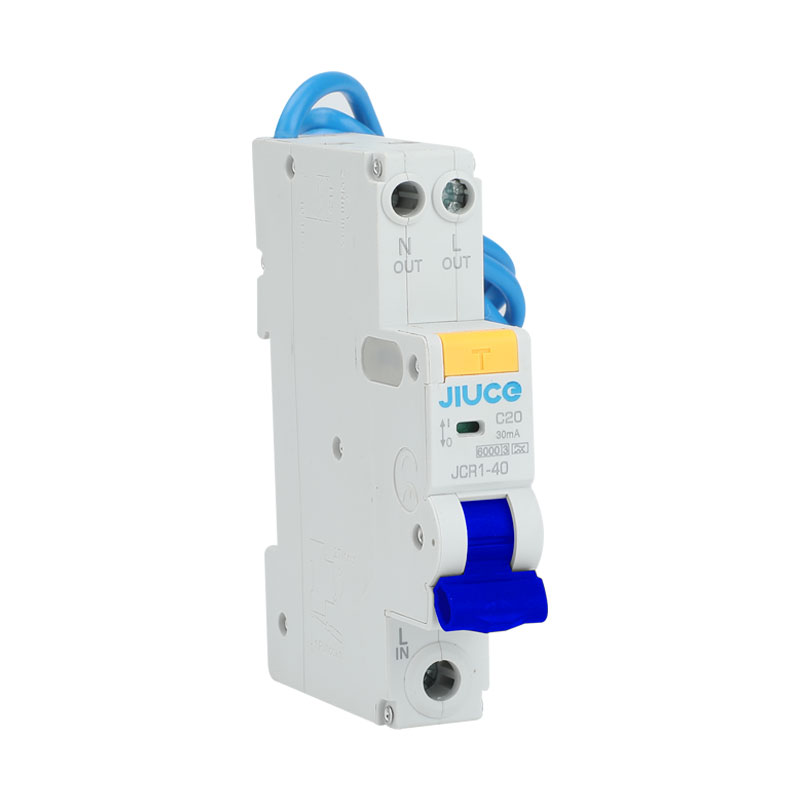JCR1-40 Single Module Mini RCBO with Switched Live and Neutral 6kA
The JCR1-40 RCBOs (residual current circuit breaker with overload protection) are suitable for consumer units or distribution boards, applied under occasions such as industrial, and commercial, high-rise buildings and residential houses.
Electronic Type
Residual current protection
Overload and short circuit protection
Breaking capacity 6kA, it can be upgraded to 10kA
Rated current up to 40A (available from 6A to 40A)
Available in B Curve or C tripping curves.
Tripping sensitivity: 30mA,100mA, 300mA
Type A or Type AC are available
Switched Live and Neutral
Double pole switching for complete isolation of faulty circuits
Neutral pole switching significantly reduces the installation and commissioning test time
Complies with IEC 61009-1, EN61009-1
Introduction:
JCR1-40 RCBO provides protection against earth faults, overloads, short circuits and domestic installation. The RCBO with both disconnected neutral and phase guarantees its proper actuation against earth leakage faults even when the neutral and phase are wrongly connected.
JCR1-40 electronic RCBO incorporates a filtering device preventing the risks of unwanted due to transient voltages and transient currents;
JCR1-40 RCBO's combine the overcurrent functions of an MCB with the earth fault functions of an RCD in a single unit.
JCR1-40 RCBO, which does the job of both an RCD and MCB, thus prevents this type of nuisance tripping and should be used on mission critical circuits.
JCR1-40 miniature RCBO's provide more wiring space in the enclosure for the installer making the whole installation process easier and quicker. During installation, resistance testing live and neutral conductors do not have to be disconnected. Now with an increased level of safety these JCR1-40 RCBO’s include switched neutral as standard. A faulty or damaged circuit is fully isolated by disconnecting the live and neutral conductors. Healthy circuits remain in service, only the faulty circuit is switched off. This avoids danger and prevents inconvenience in the event of a fault.
Type AC RCBOs are used for general purpose on AC (Alternating Current) only circuits. Type A are used for DC (Direct Current) protection, these mini RCBOs provide both levels of protection.
The A Type JCR1-40 RCBO responds to both AC and pulsating DC residual currents. It protects against both overcurrents due to overload and fault and residual current earth leakage. In either event, the RCBO interrupts the electrical supply to the circuit thus preventing damage to the installation and devices and electric shock to humans.
B curve JCR1-40 RCBO trips between 3-5 times full load current is suited for domestic application. C curve JCR1-40 rcbo trips between 5-10 times full load current is suited for commercial applications where there is greater chance of higher short circuit currents, such as inductive loads or fluorescent lighting.
JCR1-40 Available in current ratings that range from 6A to 40A and in B and C type tripping curves.
JCR1-40 RCBO Complies with BS EN 61009-1, IEC 61009-1, EN 61009-1, AS/NZS 61009.1
Product Description:

The most important features
●High quality and reliability with functional design and easy installation
●For use in domestic household and similar installations
●Electronic Type
●Earth leakage protection
●Overload and short circuit protection
●Breaking capacity up to 6kA
●Rated current up to 40A (available in 2A, 6A.10A,20A, 25A, 32A, 40A)
●Available in B Curve or C tripping curves
●Tripping sensitivity: 30mA,100mA
●Available in Type A and Type AC
●True Double Pole Disconnection in a Single Module RCBO
●Double pole switching for complete isolation of faulty circuits
●Neutral pole switching significantly reduces the installation and commissioning test time
●Insulated openings for easy busbar installations
●RCBO have a positive indication for on or off
●35mm DIN rail mounting
●The current carrying capacity of the cable should always exceed the current rating of the RCBO to prevent damage
●Installation flexibility with the choice of line connection either from top or bottom
●Compatible with multiple types of screw-drivers with combination head screws
●Meets ESV Additional Testing & verification requirements for RCBOs
●Complies with IEC 61009-1, EN61009-1, AS/NZS 61009.1
Technical Data
●Standard: IEC 61009-1, EN61009-1
●Type: Electronic
●Type (wave form of the earth leakage sensed): A or AC are available
●Poles: 1P+N ( 1Mod)
●Rated current:2A 6A, 10A, 16A, 20A, 25A, 32A, 40A
●Rated working voltage: 110V, 230V ~ (1P + N)
●Rated sensitivity I△n: 30mA, 100mA
●Rated breaking capacity: 6kA
●Insulation voltage: 500V
●Rated frequency: 50/60Hz
●Rated impulse withstand voltage(1.2/50) : 6kV
●Pollution degree:2
●Thermo- magnetic release characteristic: B curve, C curve, D curve
●Mechanical life: 20,000 times
●Electrical life: 2000 times
●Protection degree: IP20
●Ambient temperature (with daily average ≤35℃):-5℃~+40℃
●Contact position indicator: Green=OFF, Red=ON
●Terminal connection type:Cable/U-type busbar/Pin-type busbar
●Mounting: On DIN rail EN 60715 ( 35mm) by means of fast clip device
●Recommended torque: 2.5N.m
●Connection: From bottom
|
Standard |
IEC/EN 61009-1 |
|
|
Electrical features |
Rated current In (A) |
6, 10, 16, 20, 25, 32, 40 |
|
Type |
Electronic |
|
|
Type (wave form of the earth leakage sensed) |
A or AC are available |
|
|
Poles |
1P+N( Switched Live and Neutral) |
|
|
Rated voltage Ue(V) |
230/240 |
|
|
Rated sensitivity I△n |
30mA, 100mA,300mA |
|
|
Insulation voltage Ui (V) |
500 |
|
|
Rated frequency |
50/60Hz |
|
|
Rated breaking capacity |
6kA |
|
|
Rated residual making and breaking capacity I△m (A) |
3000 |
|
|
Rated impulse withstand voltage(1.2/50) Uimp (V) |
4000 |
|
|
Break time under I△n (s) |
≤0.1 |
|
|
Pollution degree |
2 |
|
|
Thermo-magnetic release characteristic |
B, C |
|
|
Mechanical features |
Electrical life |
2, 000 |
|
Mechanical life |
2, 000 |
|
|
Contact position indicator |
Yes |
|
|
Protection degree |
IP20 |
|
|
Reference temperature for setting of thermal element(℃) |
30 |
|
|
Ambient temperature (with daily average ≤35℃) |
-5...+40 |
|
|
Storage temperation (℃) |
-25...+70 |
|
|
Installation |
Terminal connection type |
Cable/Pin-type busbar |
|
Terminal size top for cable |
10mm2 |
|
|
Terminal size bottom for cable |
16mm2 / 18-8 AWG |
|
|
Terminal size bottom for busbar |
10mm2 / 18-8 AWG |
|
|
Tightening torque |
2.5 N*m / 22 In-Ibs. |
|
|
Mounting |
On DIN rail EN 60715 (35mm) by means of fast clip device |
|
|
Connection |
From bottom |

JCR1-40 Dimensions

Why use Miniature RCBOs?
RCBO (Residual Current Circuit Breakers with Overcurrent Protection) devices are a combination of an RCD (Residual Current Device) and MCB (Miniature Circuit Breaker) in one.
An RCD detects Earth Leakage, i.e. current flowing where it shouldn’t, switching the circuit off where there is an Earth fault current. The RCD element of the RCBO is there to protect people.
In housing installations it’s not unusual to find that one or more RCDs are used alongside MCBs in the consumer unit, all grouped together protecting multiple circuits. What commonly happens when there is an earth fault on one circuit is that a whole group of circuits, including healthy circuits, are switched off.
In these instances, using RCDs and MCBs in groups goes against specific aspects of the IET’s 17th Edition Wiring Regulations. Specifically, Chapter 31-Division of Installation, regulation 314.1, which requires every installation to be divided into circuits as necessary –
1)To avoid danger in the event of a fault
2)To facilitate safe inspection, testing and maintenance
3)To take account of hazards that might arise from the failure of a single circuit e.g. lighting circuit
4)To reduce the possibility of unwanted tripping of RCDs (not due to fault)

 Zhejiang Jiuce Intelligent electric co., ltd.
Zhejiang Jiuce Intelligent electric co., ltd.


















